Whether you’re just cracking open your first book on coding or a seasoned developer who’s navigated through chapters of programming languages, “Node.js” is a term you’ve likely encountered across the tech narrative.
What is Node.js, and why is it so prevalent?
Think of Node.js as the trusty sidekick in your programming adventures, not just any character in your story but a pivotal ally that brings your innovative ideas to life outside the conventional web narrative. It’s like uncovering a hidden clue that suddenly makes everything click, allowing you to construct applications as responsive and dynamic as the plot twists in a mystery novel.
Node.js has the unique ability to transform the complex into the attainable, making developing applications not just a possibility but a fun journey.
Read on to learn more about Node.js — where each line of code you write helps unlock the potential of your projects in the broad world of programming.
What Is Node.js And Why Does It Matter?
Node.js is a runtime environment used to execute JavaScript code on servers. It allows you to run JavaScript without a web browser. Node.js supports operating systems like Windows, macOS, and Linux. It is an open-source platform, so all users can access the source code for free.
Open Source
In software development, open source projects are free for anyone to download, use, modify, and distribute. WordPress is one great example of open source software, although it’s far from the only one.
Read MoreThe Node.js creators initially designed it for real-time, push-based architectures. These architectures include chatbots, notifications, streaming media, and collaboration tools, offering a way to run JavaScript on the server side.
On the other hand, JavaScript traditionally made static web pages interactive, adding features like animations and drop-down menus through “<script></script>” tags in HTML documents.
Node.js emerged as a solution to streamline this process, creating a more efficient runtime environment for JavaScript that extends its capabilities beyond web browsers, enabling developers to build scalable and high-performance applications.
The introduction of Node.js in 2009 addressed JavaScript’s inefficiency by handling many simultaneous connections without blocking. It also provides everything needed to run a JavaScript program.
Node.js is applicable across various industries, including banking, healthcare, communication, e-commerce, and entertainment. It allows you to create desktop apps, SaaS websites, and mobile applications.
Node.js Architecture
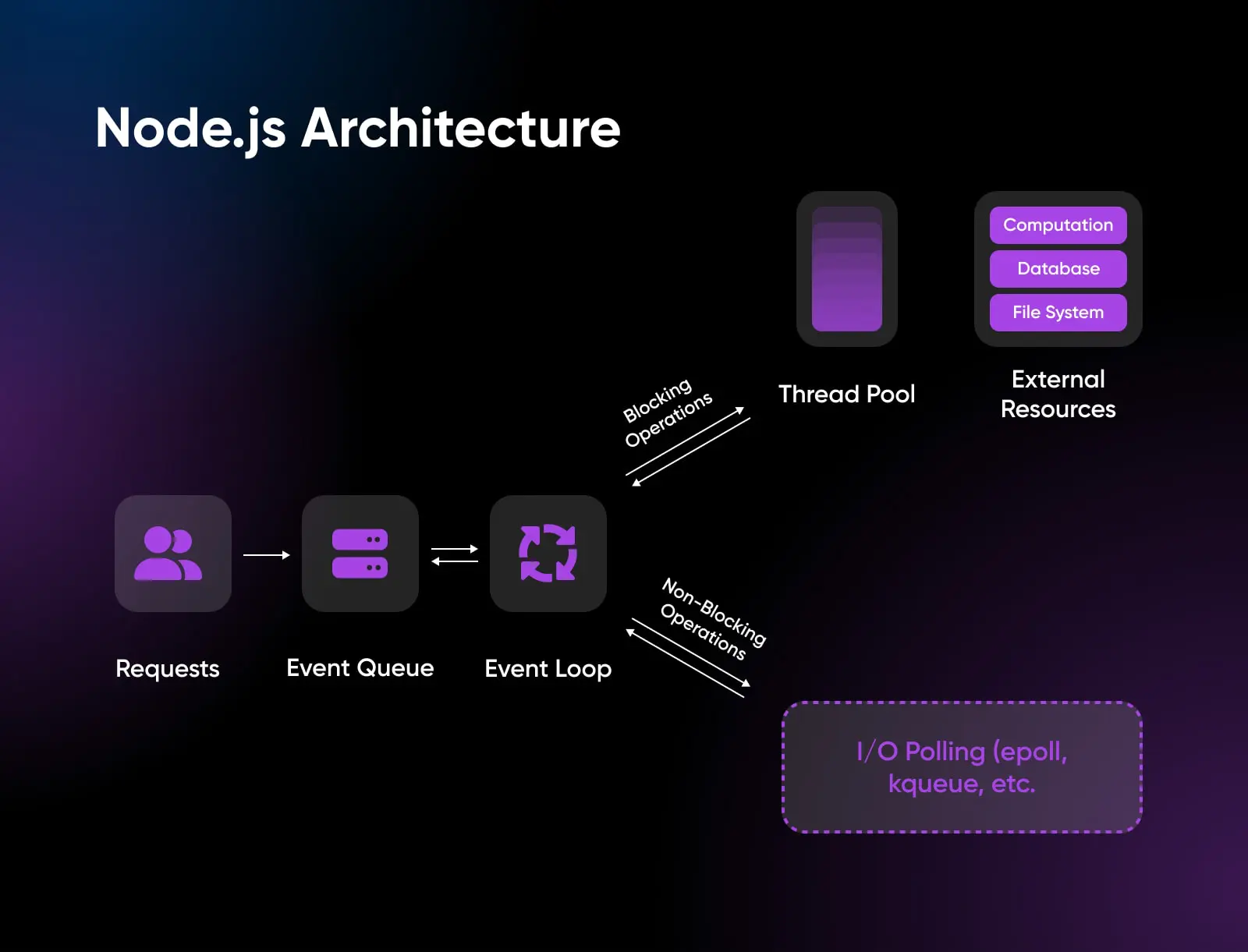
Node.js excels in handling a large number of simultaneous connections and data-intensive tasks efficiently. It’s great for tasks that involve processing large data volumes swiftly. However, it’s less suitable for compute-intensive tasks requiring significant CPU resources. In such cases, Node.js’s single-threaded nature can cause delays in responding to other requests.
To better illustrate this concept, Imagine a coffee shop. In a multi-threaded setup, each customer (server request) is served by a separate barista (thread). If all baristas are busy, new customers wait.
In contrast, Node.js is like a coffee shop with one highly efficient barista. This barista handles orders quickly and in a non-stop flow, akin to Node.js managing requests using non-blocking I/O operations. However, a complex order in this setup is like a CPU-intensive task in Node.js. It demands more of the barista’s time, slowing down service for others. This shows how Node.js, while excellent for rapid, numerous requests, can struggle with tasks that heavily tax the CPU.
The difference between single and multiple threads is simple: A single-thread architecture can perform and scale faster than multiple-thread configurations. This is what Ryan Dahl had in mind when he created Node.js.
Key Features Of Node.js
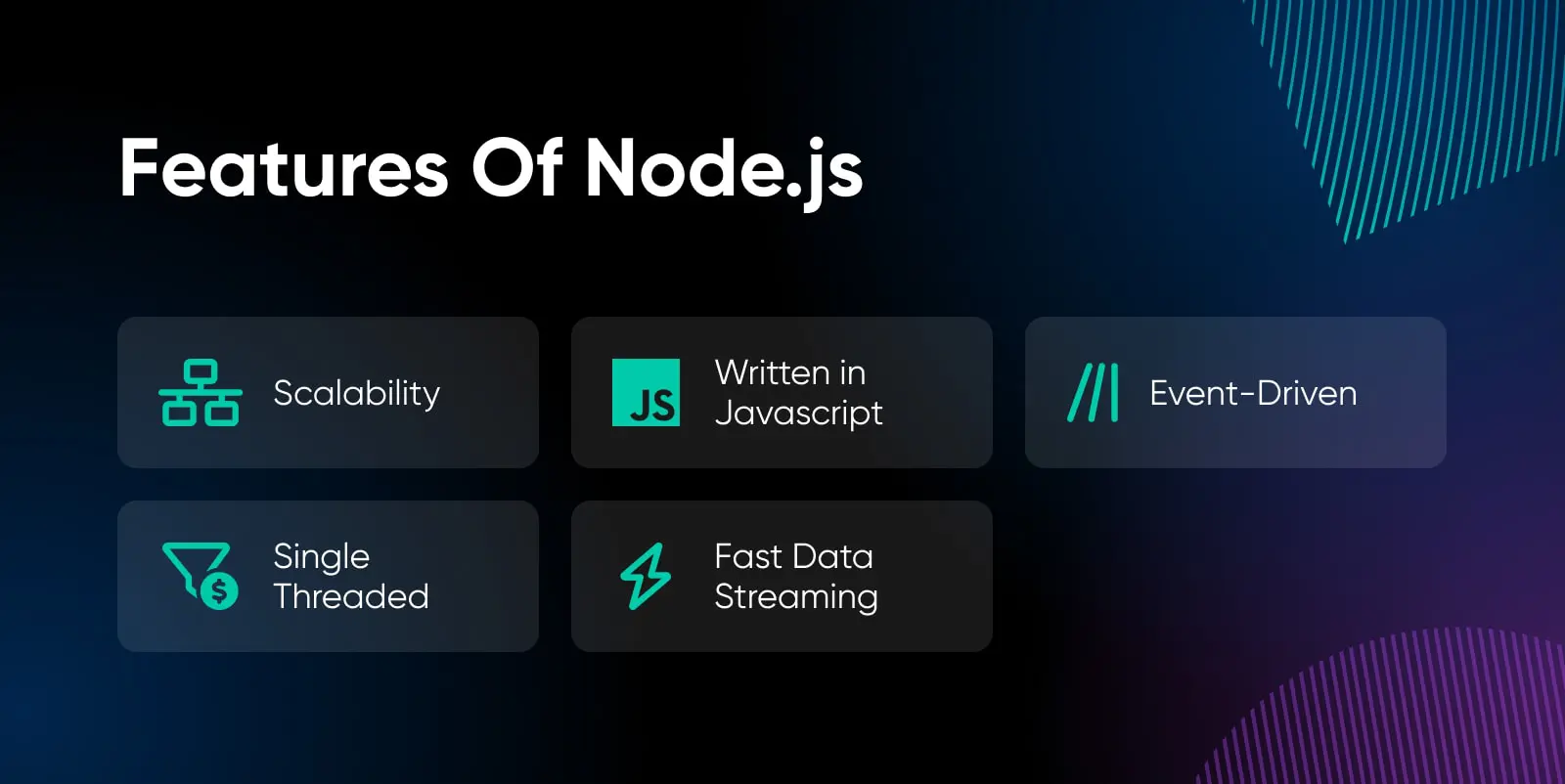
Now that you understand Node.js and how it works, let’s look at its primary features.
Scalability
In Bhadresh Panchal’s latest article, Node.js is the most used web development tool in the U.S., with over 6.3 million websites. Its most enticing feature is the ability to divide programs horizontally through “child processes.”
Child processes here make Node.js run multiple tasks at once and optimize the server’s power. They have their resources, which reduces their impact on other processes while dealing with large tasks or facing errors.
This feature enables enterprises to give various app versions to different audiences. Thereby allowing them to meet client requests for customization.
Written In JavaScript
Another key feature is its JavaScript library. If you’re comfortable working with JavaScript, Node.js will likely come easier to you. That’s why Node.js is a popular choice among developers.
In addition, using JavaScript throughout the development process promotes reliability and reuse of code. You can share code between the client and server, eliminating duplication and guaranteeing program consistency.
Event-Driven Architecture
In Node.js, everything revolves around events. You trigger events when you interact with your application, such as submitting a form or clicking a button.
These events are small bits of code that run when specific actions occur. The event-driven feature enables Node.js to manage several jobs simultaneously without lagging.
Single Threaded Language
Node.js processes all requests using a single thread within what’s known as the event loop. This is akin to a juggler who keeps multiple balls in the air. Rather than focusing on one ball (task) until it’s caught (completed), the juggler continuously tosses and catches several balls, keeping them all moving smoothly in the loop. Similarly, Node.js doesn’t wait for one task to finish before starting the next. Instead, it efficiently switches between tasks, keeping the workflow continuous and responsive.
This single-threaded approach makes Node.js particularly adept at handling input/output-bound activities, which are tasks that involve reading from or writing to external sources like files and databases. Imagine a receptionist who quickly handles incoming calls and paperwork. They don’t spend too long on any single call or document. Instead, they efficiently manage multiple tasks by quickly switching between them, ensuring a steady flow of work. This is how Node.js efficiently handles multiple I/O tasks, making it a great choice for applications with lots of data transactions but less suited for CPU-heavy tasks.
Fast Data Streaming
Node.js uses the JavaScript V8 engine. The integration of this advanced engine boosts speed and enables web applications to handle rapid data streams.
Furthermore, it facilitates the management and processing of large amounts of data. It also ensures that everything runs fast and without delay. This feature makes it an ideal choice for real-time data processing applications.
What Distinguishes Node.js From Other Frameworks?
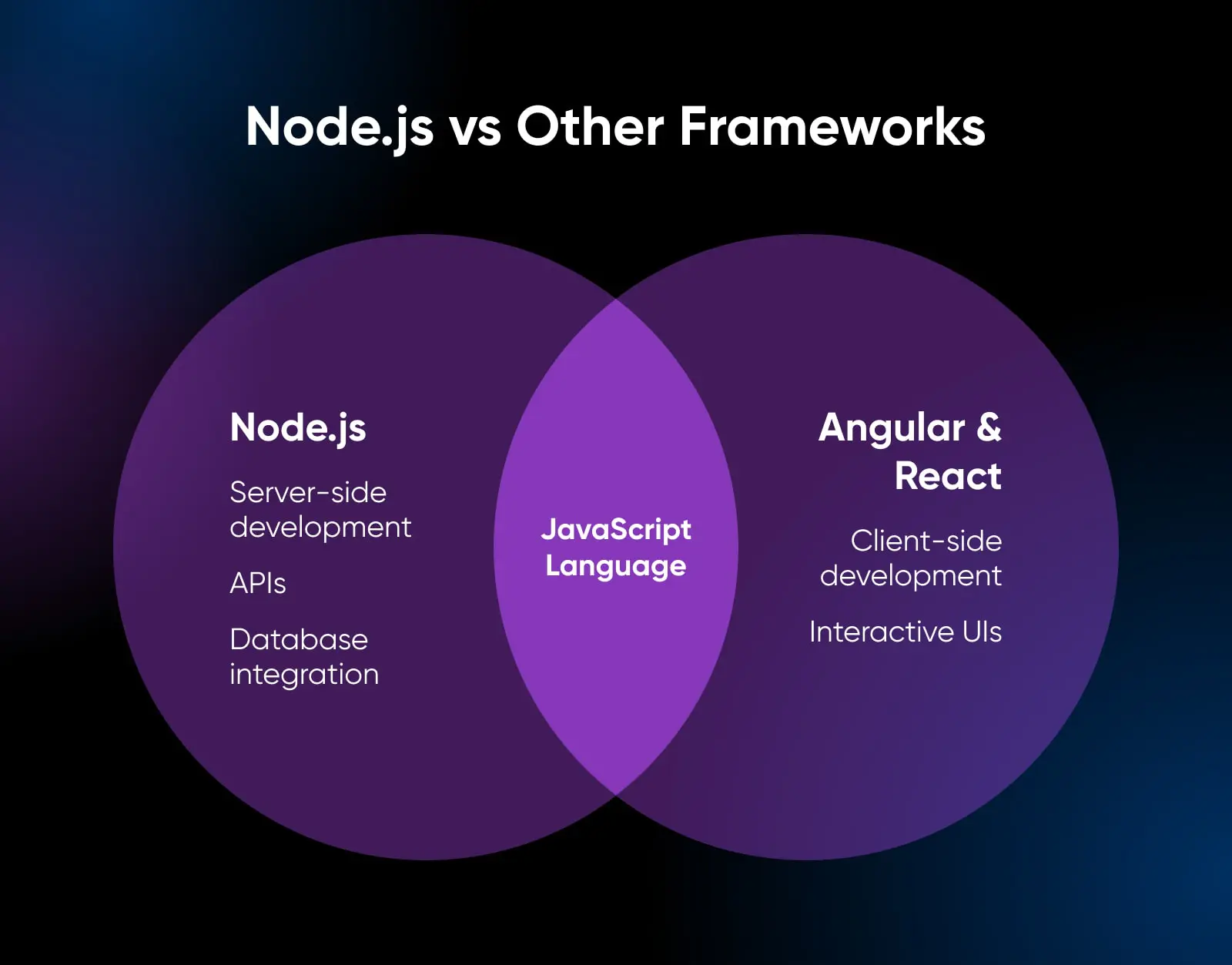
Even though the programming language used by Node.js and other frameworks is the same, Node.js operates differently from other JavaScript frameworks. It uses a unique set of APIs (Application Programming Interface).
Unlike other frameworks, Node.js APIs cater to back-end development. These include the built-in module called “HTTP” streams, file system support, and child processes.
In addition, the platform has a comprehensive package ecosystem named npm (Node Package Manager). Developers can access pre-built modules and libraries with over a million packages accessible.
Top 10 Business Applications For Node.js
1. Server-Side Proxies
Node.js is well-suited for creating server-side proxies and network applications. It can aggregate data from multiple third-party sources and efficiently handle a high volume of concurrent connections.
2. Real-Time Applications And Chatbots
Node.js is commonly used to build real-time chat features on websites. It allows developers to create events and notifications that can be used to enable instant messaging between users. This makes Node.js an important technology for companies wanting to add chat options similar to Skype or Facebook Messenger.
3. Data Streaming
Data streaming requires a continuous flow of information created by various sources and devices. Traditional media streaming treats HTTP requests and answers as separate events, even though they are streams.
You can use Node.js to create robust data streaming features that allow files to be processed while uploading. This is possible because data enters via a stream and may be handled online without interruption. For example, real-time audio or video transcoding is possible with JavaScript libraries like Node.js.
4. Stock Trader’s Dashboard
Brokers depend on trading software to keep track of stock prices, conduct computations, and use technical analysis tools to make informed decisions. However, navigating multiple screens and software programs takes time and effort.
Why not use Node.js to develop a real-time web-based solution for brokers?
You can use the tool to build such an application since it can stream data from APIs. Also, it works with web sockets to provide real-time updates.
5. Command-Line
Creating command-line applications is another area where Node.js shines. A command-line application (CLI app) is a program that runs in the terminal or command prompt.
These apps allow businesses to automate operations, manage files, and conduct specified actions without a graphical user interface. Node.js modules such as commander, yargs, and oclif make building command-line programs simple, fast, and cost-effective.
Node.js enables developers unfamiliar with backend languages to use JavaScript outside the web and create various workplace automation solutions. Businesses can use JavaScript to develop strong workplace automation solutions and other command-line tools.
6. Microservice Architecture
Tech giants like Amazon, Facebook, and Netflix have contributed to the popularity of microservices architecture in recent years.
Node.js is suitable for building this approach. It makes installing several server instances for particular microservices easy and creates proper routing addresses for each one.
According to a Statista poll, 81.5% of firms already use microservices. Companies may use Node.js to speed up their apps while decreasing the entire code base. This results in faster software development cycles and improved performance.
7. Big Data And Analytics Solutions
Node.js streams allow you to build an effective pipeline in which data starts at one point and ends at the other.
Therefore, it is best to have a mechanism for breaking large amounts of data into smaller chunks. This will help you deal with the stress of handling massive volumes of data.
Using a computer’s resources by implementing Node.js and applying back pressure to process large volumes of data is possible.
8. Web Scraping And Automation
It is impossible to manually extract millions of data points from many online sources. Likewise, analyzing such a large amount of data might be challenging to manage or deploy.
Data scraping is the automatic collection of information or extracted data from websites. Examples of data you can scrape from the web are product information, customer reviews, real estate listings, location, and features.
Node.js most often used libraries for web scraping are “request” and “cheerio.” The request package is used to download web pages. Conversely, cheerio builds a DOM (Document Object Model) tree and includes a portion of the jQuery function set for manipulation.
9. Single-Page Applications (SPAs)
Another frequent use of Node.js is to create complex single-page applications. This is ideal for data-driven single-page apps, where an entire application fits on a single page.
Here, the server serves as the backend and sends data to the client, while the client-side handles HTML rendering. These advancements will improve the maintenance of your single-page project and shorten development time.
10. Real-Time Collaboration Tools
Real-time collaboration tools are software solutions used for project management. These tools allow for co-browsing, audio and video conferencing, and collaborative document editing.
There are so many concurrent requests for these solutions. For example, with a project management application, many users can leave comments, change status, and attach documents to a given project.
Node.js helps businesses develop real-time collaboration tools since it effectively manages heavy activities and requests. For instance, Trello used NodeJS’s event-driven design to update its collaboration environment.
5 Common Tools And Frameworks Used With Node.js Server
A framework is a pre-built software structure that serves as a foundation for creating web applications. It includes libraries, modules, and protocols for streamlining development duties like routing, database interface, and authentication.
Frameworks help you to streamline development, maintain an organized codebase, and construct scalable web applications.
Below are some common tools and frameworks used with Node.js:
1. Socket.io
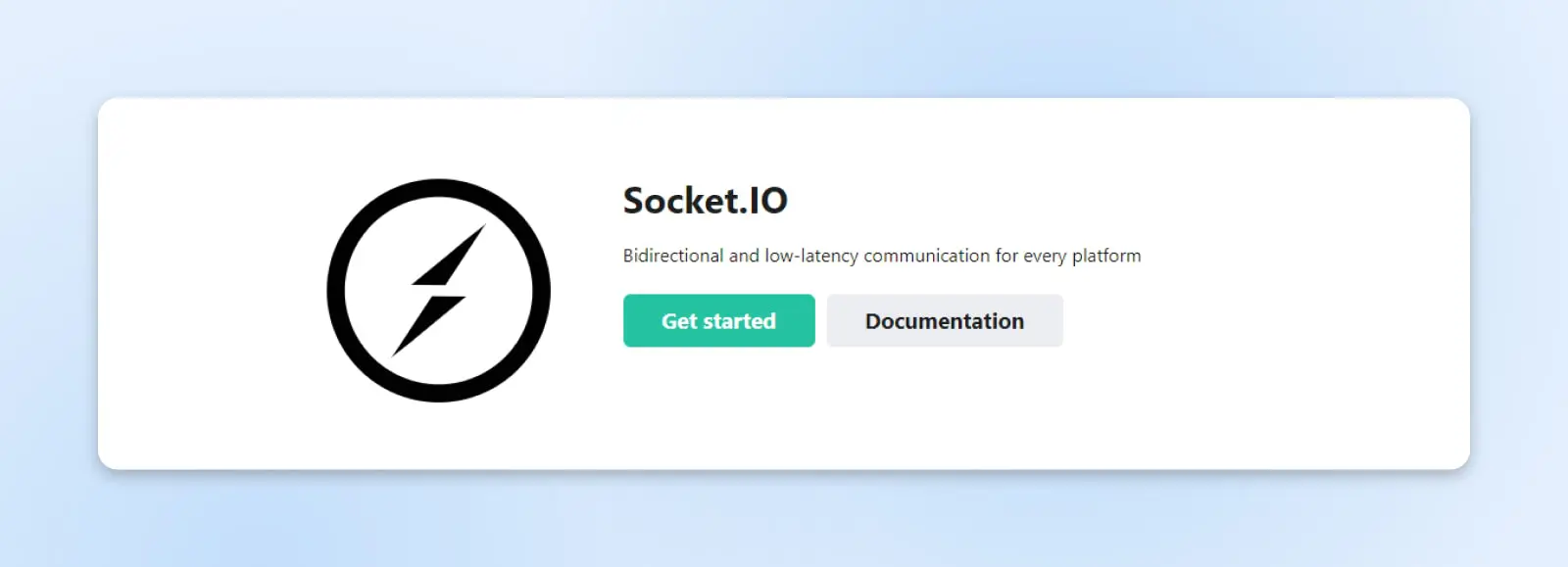
This framework supports real-time, bidirectional communication between a client and a server. Socket.io is a full-stack Node.js platform that accepts different programming languages.
Web builders facing complex challenges in a web project, such as real-time communication between clients and servers, often turn to Socket.io. This is because it offers real-time statistics and quick help.
This framework supports multiplayer games, video conferencing applications, and other interactive real-time functionalities.
2. Mongoose

This tool is an Object Data Modeling (ODM) library that works with MongoDB in Node.js applications. Mongoose handles data associations, performs schema validations, and converts objects in code to MongoDB object representations.
For example, let’s say you’re building a web application with Node.js that needs to store and retrieve data from a MongoDB database. Mongoose can define your data models using schemas to represent the data structure.
Then, you can use these models to perform operations such as creating, reading, updating, and deleting documents in the database. It simplifies the interaction between Node.js and MongoDB.
3. Express.js
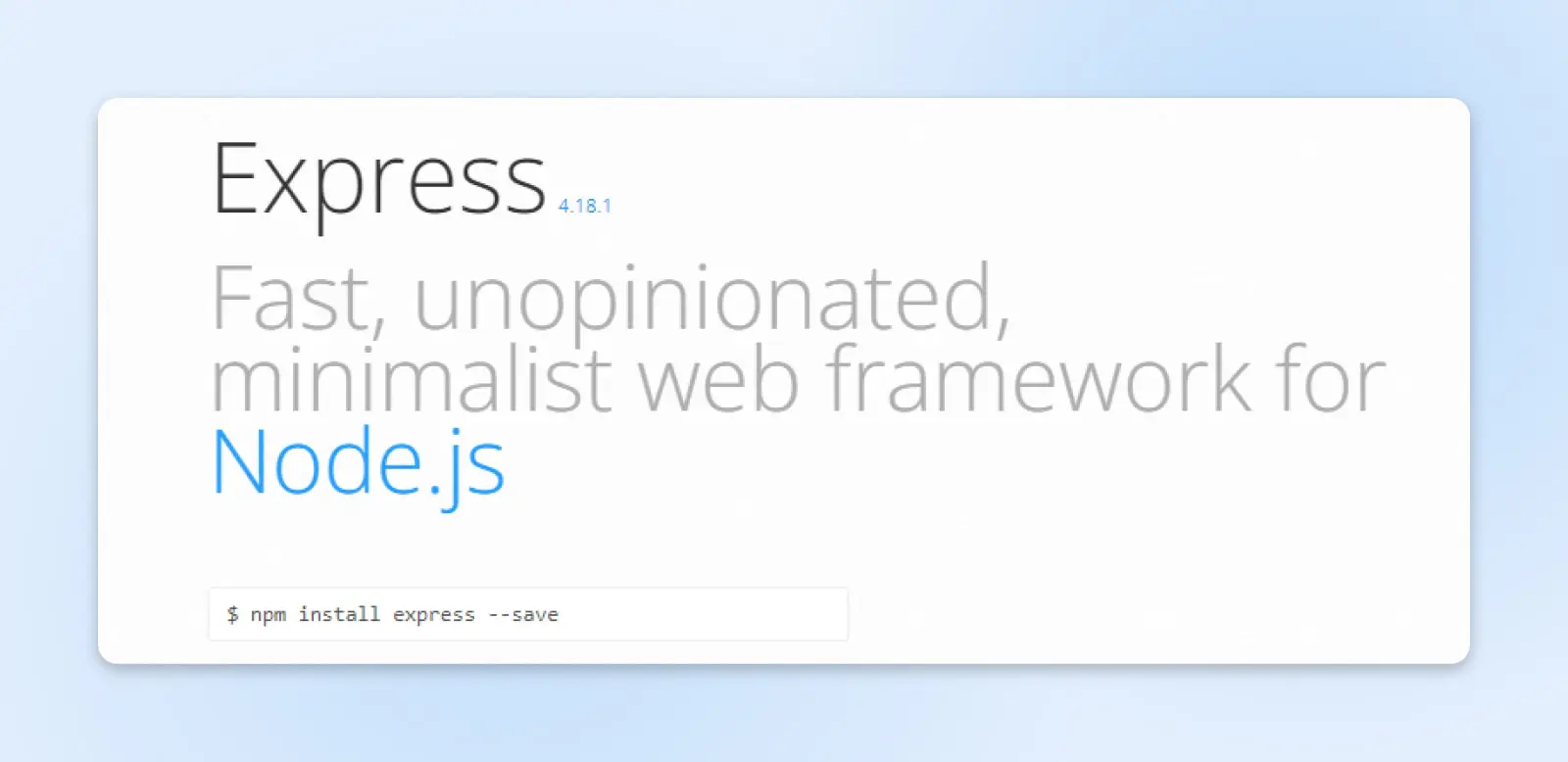
Express.js (Simply Express) is a popular and basic framework for building online apps and APIs. It is open source, free, and distributed under the MIT license. Express.js is the fastest Node.js framework, which allows developers to build server-side solutions.
Experienced developers use this framework to create enterprise-grade programs. However, it is not suitable for novices.
4. Babel
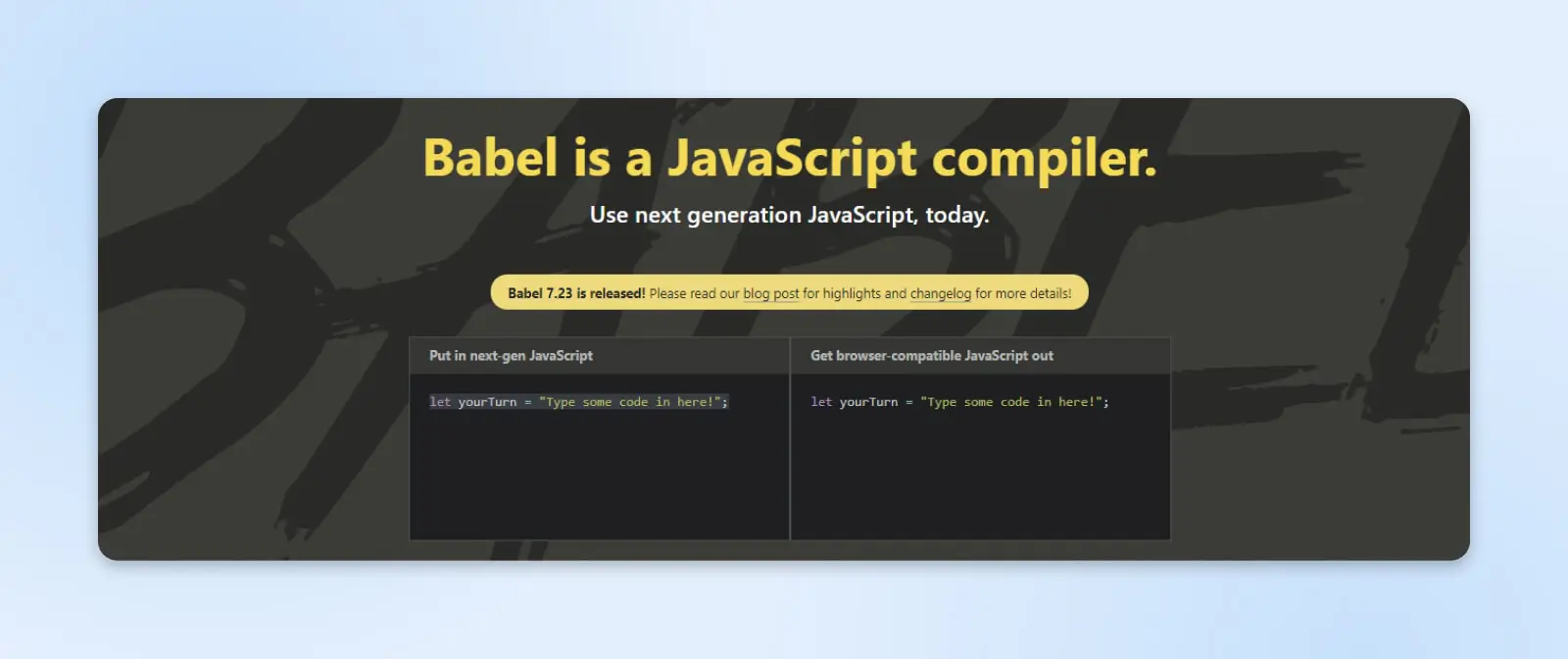
Babel is a great tool for compiling ES6+ JavaScript code into a backward-compatible version of JavaScript. It is a front-end development tool supporting JavaScript’s most recent version.
Furthermore, Babel can change syntax and support features such as polyfill. But it does not include any built-in plugin.
5. NPM
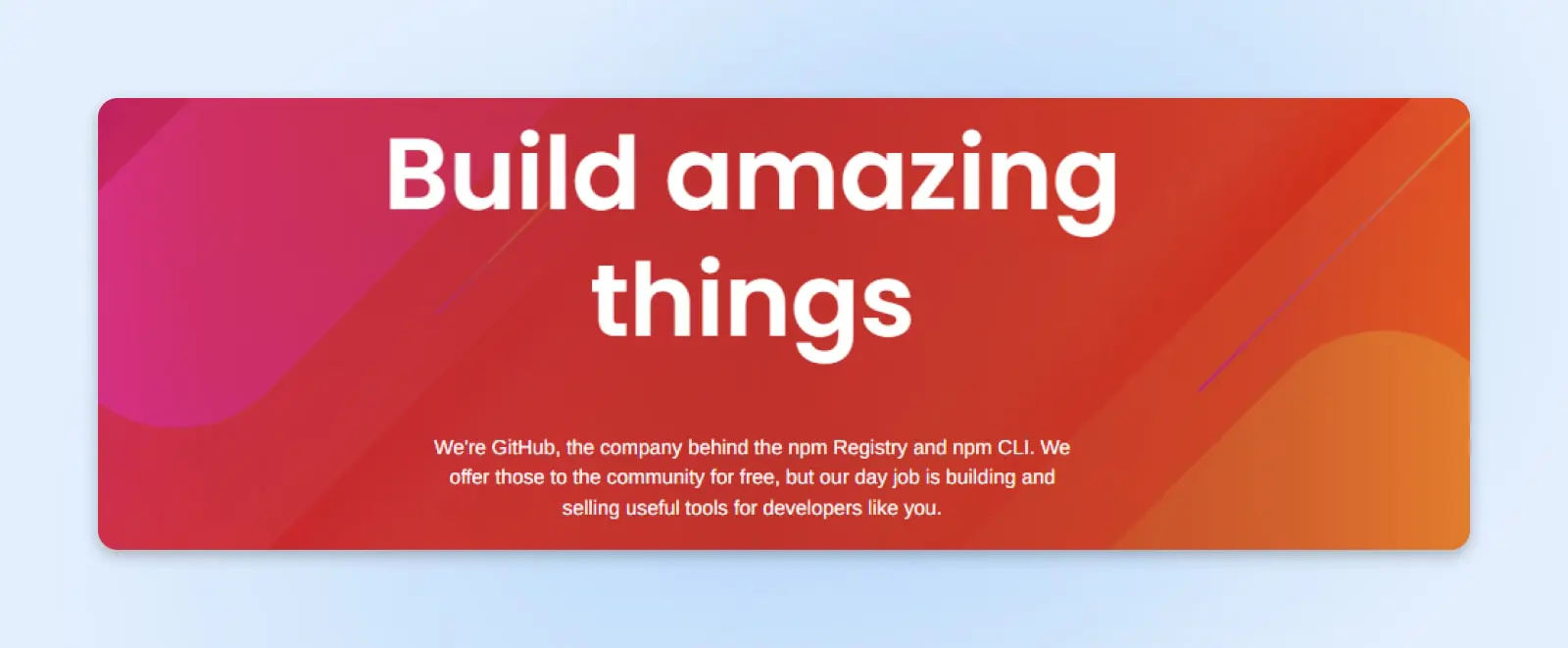
As a Node.js package manager, NPM enables developers to install and manage Node.js packages. When you install Node.js, the NPM application and built-in support will also install on your computer. This tool allows developers to download and install packages with JavaScript code.
FAQs
What is Node.js?
Node.js is a server-side, open-source JavaScript runtime environment. Node relies on Google’s V8 engine, libUV, to provide cross-platform connectivity.
What is Node.js used for?
Node.js is used to develop fast applications that enable real-time communication, data streaming, and browser gaming. Developers also use Node.js to create web servers, APIs, and microservices.
Is Node.js a framework?
Node.js is not a framework but a runtime environment.
What is the difference between Node.js and JavaScript?
JavaScript is a computer language you can apply to front-end and back-end development. Meanwhile, Node.js is a runtime environment that allows JavaScript to be performed on the server. In short, JavaScript is a language, and Node.js is a platform allowing server-side execution.
Get Started With Node.js
Node.js is a fantastic tool for anyone looking to build fast and reliable online applications. It’s user-friendly enough for beginners but also powerful enough for seasoned developers.
Ready to bring your web project to life?
DreamHost’s hosting services are the perfect place to start. They provide the support and resources you need to get your Node.js application up and running smoothly.

Secure Cloud Storage Hosting
DreamObjects is an inexpensive object storage service great for hosting files, storing backups, and web app development.
Try It Free for 30 Days
